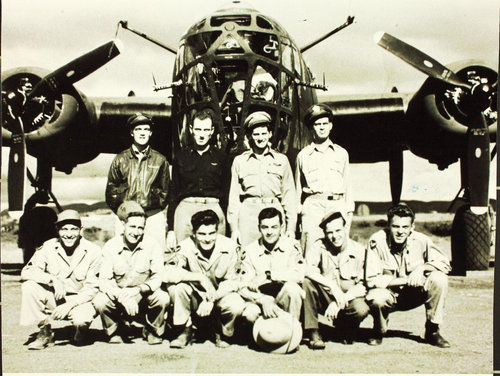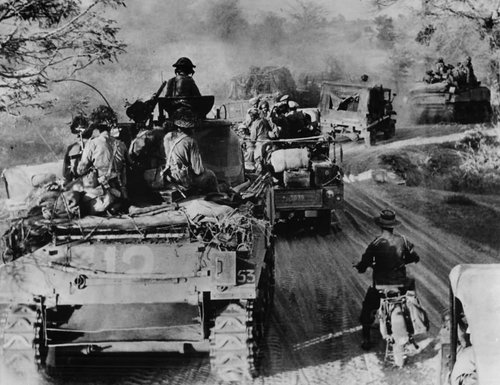Loading...
By James D. Campbell
Just as the leaders and thinkers within the joint force are becoming more dedicated to the notion that a post-joint understanding of complex future military operations should be framed by the concept of multi- or cross-domain operations, the Joint Warfighting Department at the Air Command and Staff College has similarly altered its instruction of joint capabilities and planning. The department exchanged the traditional service-centric presentations, and discussions of capabilities and employment of forces, replacing them with a series of seminars covering military operations within the various domains of battle. So, instead of viewing military operations through the lens of a service structure, the department is emphasizing holistic joint force capabilities; the manner in which these capabilities facilitate access to, and maneuver within, the battlespace; and the various effects they can achieve by combining and synchronizing actions within and through the land, air, maritime, space, and cyber domains.
In addition to making these and other adjustments to the warfighting and operational planning curriculum, the department is tying the doctrine covered in each lesson to a range of historical and contemporary examples that serve to illustrate these nascent concepts. One of the most fruitful sources for examples illustrating the concepts behind multi-domain warfare is the World War II campaign history of the British Commonwealth 14th Army’s approach to combined operations within the Allied Southeast Asia Command in the China-Burma-India Theater.
ONE OF THE MOST FRUITFUL SOURCES FOR EXAMPLES WHICH ILLUSTRATE THE CONCEPTS BEHIND MULTI-DOMAIN WARFARE IS THE WORLD WAR II CAMPAIGN HISTORY OF THE BRITISH COMMONWEALTH 14TH ARMY’S APPROACH TO COMBINED OPERATIONS WITHIN THE ALLIED SOUTHEAST ASIA COMMAND IN THE CHINA-BURMA-INDIA THEATER.

14th Air Force, Bombardment Group, 16th Squadron
Field Marshal 1st Viscount William Slim has been long known among students of military leadership and the operational art. Slim’s war memoir, Defeat into Victory is one of the classics of the genre.[1] However, Slim’s leadership of the 14th Army also provides some excellent examples of innovation in the face of both logistical austerity and the severe operational challenges posed by a forbidding environment and a tough adversary. Slim’s creativity and cooperation with his counterparts in the Allied Southeast Asia Command are useful in demonstrating how effective a well-led force can be when it slips the bounds of a more traditional understanding of capabilities tied to service bailiwicks. Of particular interest at the Air Command and Staff College are the ways in which Slim and the leadership of the 14th Air Force and the Allied Southeast Asia Command used airpower not only in its more familiar contemporary roles, but also to conduct ground force maneuver, extend the operational reach of ground forces, sustain forward-stationed and even surrounded ground units, and provide responsive and accurate fires in places where field artillery was ineffectual due to terrain and weather. This is, of course, to say nothing of the monumental efforts of airpower in providing logistical support to the nationalist Chinese armies over the Himalayas, known as The Hump. In essence, during the campaigns in the China-Burma-India Theater, Slim’s 14th Army and the other organizations within the Allied Southeast Asia Command, developed and executed many of the concepts of airpower-facilitated maneuver, sustainment, and fires later used in the small wars of the post-World War II era, as well as in conflicts occurring around the world today.
 In many ways, these concepts fundamentally define cross-domain operations, visualizing and executing operations with simultaneity and depth through the air and on the land to dislocate the adversary and outpace his ability to respond. Developing his operational concept for the Imphal/Kohima battles in 1944, Slim founded his planning on the idea that not only would he expect his major ground forces to be surrounded, he actually wanted them to draw the Japanese into a battle where they would be forced to overextend themselves by encircling his defenses. Slim was confident he would be able to sustain his major formations entirely from the air. In fact he determined the defensive dispositions of his maneuver elements based on the locations of all-weather airfields. He also built into his planning the re-positioning of entire divisions using C-47s from Air Transport Command, thereby substituting air movement for ground maneuver.[2] Slim ensured his ground forces—constrained by some of the most forbidding mountain and jungle terrain in the world coupled with the incoming rains of the monsoon season—would have dedicated air units exercising the critical functions of reconnaissance, fires, and sustainment, and the air-ground cooperation between elements of the 14th Army and 14th Air Force in the China-Burma-India Theater displayed some of the most effective cross-service integration of the entire war.
In many ways, these concepts fundamentally define cross-domain operations, visualizing and executing operations with simultaneity and depth through the air and on the land to dislocate the adversary and outpace his ability to respond. Developing his operational concept for the Imphal/Kohima battles in 1944, Slim founded his planning on the idea that not only would he expect his major ground forces to be surrounded, he actually wanted them to draw the Japanese into a battle where they would be forced to overextend themselves by encircling his defenses. Slim was confident he would be able to sustain his major formations entirely from the air. In fact he determined the defensive dispositions of his maneuver elements based on the locations of all-weather airfields. He also built into his planning the re-positioning of entire divisions using C-47s from Air Transport Command, thereby substituting air movement for ground maneuver.[2] Slim ensured his ground forces—constrained by some of the most forbidding mountain and jungle terrain in the world coupled with the incoming rains of the monsoon season—would have dedicated air units exercising the critical functions of reconnaissance, fires, and sustainment, and the air-ground cooperation between elements of the 14th Army and 14th Air Force in the China-Burma-India Theater displayed some of the most effective cross-service integration of the entire war. BY REMOVING BARRIERS AND FACILITATING ACTIONS ACROSS AND THROUGH MULTIPLE DOMAINS, SLIM’S RE-CONCEPTUALIZATION OF TRADITIONAL APPLICATIONS OF THE JOINT FUNCTIONS: COMMAND AND CONTROL, MOVEMENT AND MANEUVER, FIRES, SUSTAINMENT, INTELLIGENCE, PROTECTION, AND INFORMATION MARKS SOMETHING OF A REVOLUTION IN THE WAY MODERN WARFARE WAS CONDUCTED.
In the operations designed to drive the Japanese from Burma, Slim added aerial insertion, maneuver, and sustainment of entire large units designed to unhinge Japanese command and control, logistics, and defensive dispositions. He also relied on riverine operations for sustainment and maneuver. First with the Chindits and then with the 5307th Composite Unit, also known as Merrill’s Marauders, the 14th Army in the China-Burma-India Theater extended their operational reach deep into Japanese-controlled territory, again demonstrating utilization of military forces in ways never seen before. Slim’s coordination of his conventional forces with airpower-supported special operations forces, and the unconventional warfare capabilities of Office of Strategic Services Detachment 101 operating with the Kachin tribesmen of northern Burma, demonstrated his ability to confront the Japanese with multiple simultaneous dilemmas throughout the breadth and depth of the battlespace.[3] All these operations were planned and executed in a manner that capitalized on understanding the possibilities inherent in erasing boundaries and distinctions between previously understood modes of operation. By removing barriers and facilitating actions across and through multiple domains, Slim's re-conceptualization of traditional applications of the joint functions (command and control, movement and maneuver, fires, sustainment, intelligence, protection, and information) marks something of a revolution in the way modern warfare is conducted.

British M4 Sherman tanks and infantry advance to Meiktila Burma
Slim’s leadership of these complex operations occurred in a political-military environment fraught with difficulties. He had to balance the competing interests of the United States government, most often in the in the persons of General Joseph Stilwell, the American China-Burma-India Theater commander, who wanted to ensure the survival and sustainment of the Chiang-Kai-Shek regime, and General Claire Chennault, commander of the 14th Air Force. These considerations sometimes clashed with those of the British Empire in restoring its control of Burma and elsewhere in the region.[4] Additionally, Slim’s 14th Army was composed of soldiers from nearly the entire British Commonwealth: Australians, New Zealanders, West and East Africans, West Indians, Canadians, British troops, and, of course, the bulk of the force came from the Indian Army. Added to this amalgamation were the Chinese divisions commanded by Stilwell, the American troops of Merrill’s Marauders, the 14th Air Force, and Slim’s line of communications in Bengal and Assam.[5] All of these contingents had specific cultural differences and competing logistical requirements—at one point the 14th Army was maintaining up to 43 separate ration lines, to say nothing of the need to satisfy their home governments.[6] Beyond these complexities, the entire campaign was fought while India’s independence movement was creating turmoil and violence in Slim’s rear areas.[7]
Slim navigated these relationships and conflicts in such an adroit manner that the prickly Stilwell, who notoriously disliked British officers, rated Slim highly.[8] Slim welded together his polyglot force into a high-functioning organization, sustained it despite the extraordinary challenges and political machinations in his support areas, and led it to victory over one of the toughest and most experienced adversaries faced by the Allies anywhere during the war. In all this, Slim displayed just the traits of leadership we want in the officers of our joint force today: agility and innovation, independent critical thinking, rapid and ethical decision-making, empathy and care for subordinates, expertise in the tools of the trade, and poise under pressure. Slim was, and remains, one of the most beloved and highly regarded commanders of the twentieth century.
For all of these reasons, the Air Command and Staff College Joint Warfighting Department has found the numerous cases in the China-Burma-India Theater are useful in teaching multi-domain operational concepts and are enhanced by pairing discussions of operational art and design with a discussion of the kind of leadership needed to carry out these concepts. There is no better example of the kind of leadership needed to execute these concepts than that of Field Marshal William Slim.
James D. Campbell, Ph.D. is an Associate Professor at the Air Command and Staff College. He is a retired U.S. Army Brigadier General, and is an historian of Britain and the British Empire. The views expressed in this article are those of the author and do not reflect the official policy or position of the U.S. Air Force Air and Command Staff College, U.S. Air Force, the Department of Defense, or the U.S. Government.
Loading...
No responses yet for "Teaching Multi-Domain Operations: The Case of British Field Marshal William Slim"
Post a Comment